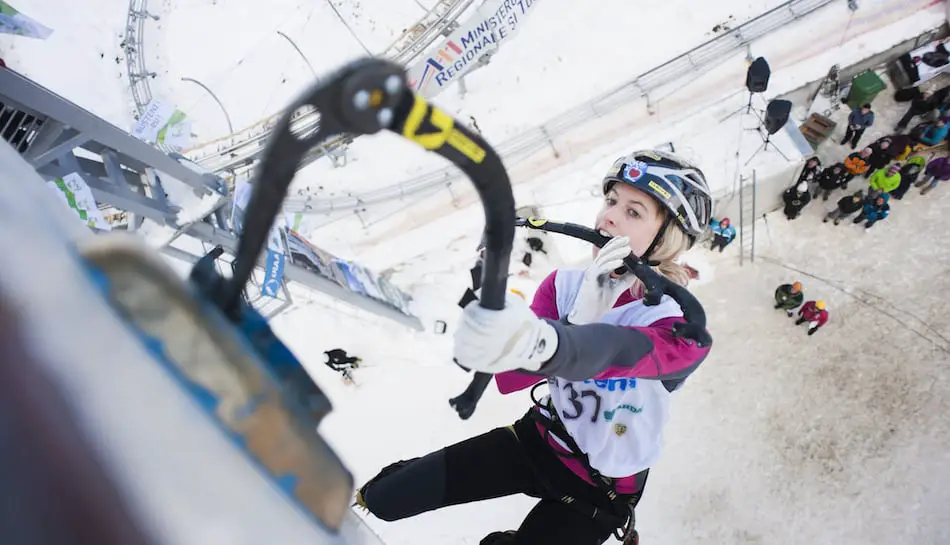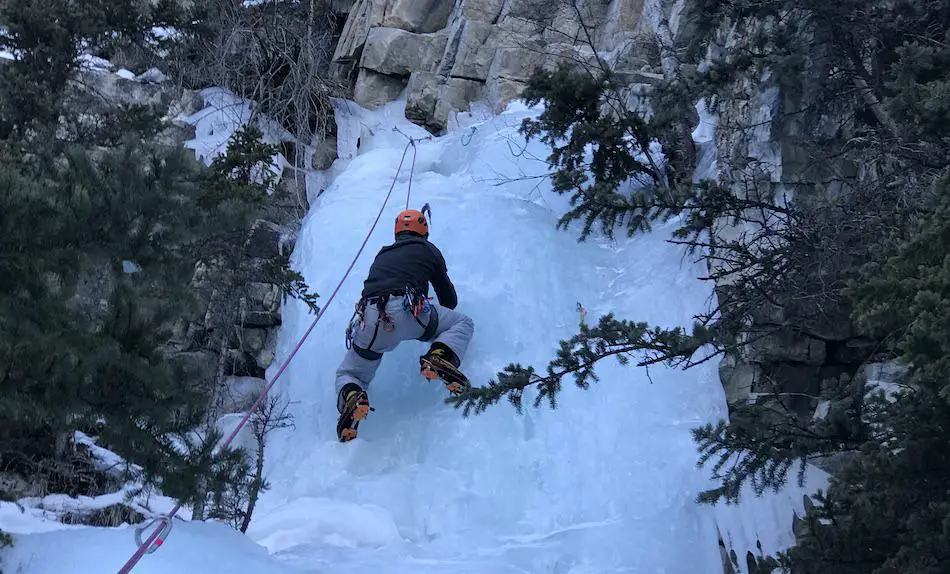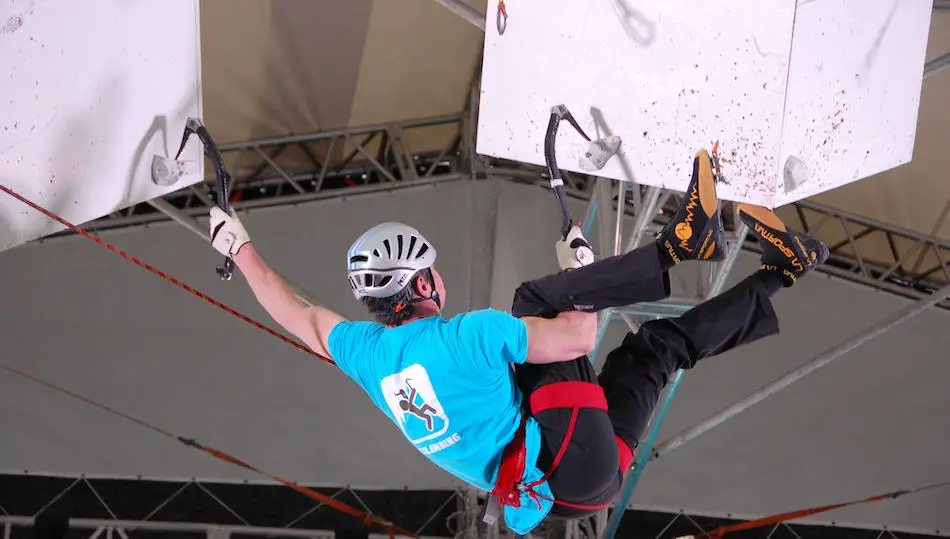
Some activities can be hard to classify as sports. I did some research to see if ice climbing qualifies!
So, is ice climbing a sport? Yes, ice climbing qualifies as a sport. It’s a high-intensity physical activity, and one in which the competition scene is starting to become more mainstream. This firmly solidifies ice climbing as a sport.
Webster’s defines a sport as: “An activity involving physical exertion and skill in which an individual or team competes against another or others for entertainment.” Under that definition, ice climbing most definitely qualifies as a sport, although it’s probably more obscure than some other sports out there. Anyone who’s every ice climbed before knows how tiring it can be. Furthermore, ice climbing competitions are just starting to find their feet in terms of establishing a format and becoming a little bit more recognized.
Ice Climbing and Physical Exertion
Now, you could probably make the argument that some sports set the bar low in terms of the ‘physical exertion or skills’ required to qualify them as a sport (I’m looking at you, darts/poker). Ice climbing, however, is a clear candidate for this category.
The thing about ice climbing is that it’s a full-body workout, and one that often lasts an entire day. You’re on your feet for hours at a time, often with a heavy backpack and lots of gear on— and that’s before you even start climbing. To understand more the physical exertion that ice climbing puts on your body, lets break it down into specific body parts.
Upper Body

Your arms and shoulders bear the brunt of the toll when you’re ice climbing. With your entire weight hanging off your forearms, it’s no surprise that they tend to tire quickly and cramp up. The act of holding yourself straight with your axes for purchase can also wear out your biceps.
Shoulders are where a lot of the action happens, because of the repetitive swinging motion required to drive your axe into the ice. You may have to swing 3-5 times, while holding a 5-pound weight full extended above your head, before the pick sticks into the ice. That’ll gain you about 8 inches of vertical distance; on a 30-meter ice climb, all of those swings add up.
Lower Body
In terms of lower body, your calves are going to feel extremely sore after a day of ice climbing. This is because of the exertion required to keep yourself standing straight when your crampons are driven into the ice. It’s like trying to do a calf raise, except you need to hold the position for ten minutes while you work your way up the wall.
Calves aren’t the only thing that get a workout, either. Your quads and glutes are going to become activated as you kick your way into the ice. Check out the picture below illustrating proper ice climbing form:

See how my legs are completely bent? Out of this position, I then need to stand up straight so I can place my axes higher. This movement, repeated tens of times on one climb, can start to wear you down.
Furthermore, you need your legs to get to the ice climb in the first place. Most waterfalls don’t happen right beside the road, so you could be walking for an hour or more, all the time carrying a pack that probably weighs at least 30 pounds. This puts more stress on your quads and calves; it’s similar to carrying a staircase while holding a dumbbell in each hand.
Core
Although sometimes overlooked, your core is also important when ice climbing. It’ll get as little bit of activation on the walk in, to help keep you steady when your pack is trying to pull you in different direction.
Your core really gets a workout once you start climbing, though. Ice climbing requires good balance and body positioning to prevent your tools from losing their grip on the ice. Your abs and core are essential to prevent this from happening.
Stamina
Finally, you need to have the stamina in your muscles to keep all of these movements up for long periods of time. Your forearms and calves are going to feel the strain most acutely, because they’re going to need to be constantly activated for the duration of your climb.
Skill Component
Ice climbing also involves a high degree of skill. In fact, I would argue that this is far more important than any of the physical components. Knowing where to place your axes and feet, how to get the maximum force into your swing, and moving in such a way as to keep your tools properly loaded, are all skills that take years to develop.
Ice Climbing Competitions

So, we’ve now talked about how ice climbing definitely requires physical exertion. Now let’s look at the competition side of it.
Most ice climbing competitions are held through the International Climbing and Mountaineering Federation (UIAA), which has established a World Cup circuit for the sport. Many smaller, regional competitions in the US and European countries will also be run, which can help people familiarize themselves with the World Cup format.
There are two main disciplines that climbers compete in: Lead and Speed.
Lead
Lead competitions take place on overhanging terrain that is designed to have a variety of complex, dynamic moves for the ice climbers to perform. The routes are often made out of artificial ice climbing structures, which helps standardize the competition and makes it easier for route setters to create challenging sequences.
Watching a lead route often looks absurd: there are massive structures tilted, giant blocks of ice hanging on chains, and climbers chucking around insane moves to help work their way up. Figure four’s, figure eight’s, and other dynamic movements are common (in a rare instance, you might actually see people dynoing with ice axes).
Falls occur frequently, which is a contrast to more traditional ice climbing disciplines. To prepare for this, the climbers where specialized ‘fruit boots’ that are designed to allow for falls without getting as stuck as a pair of crampons would.
Speed
Speed competitions are less well known, but they’re starting to gain popularity because of their simplicity, intensity, and entertainment factor. The rules are simple: the first one to the top wins. Some competitions have everyone climb one wall and then compare times, while others pit the climbers against each other in a head-to-head battle.
These races are done on real ice, with the climbers on top-rope to prevent damage from any falls. The routes are 15-20 meters long, and races are usually done in twenty seconds or less.
Here, climbers use more specialized tools to help them make their way up the wall as quickly as possible. Similar to lead climbing, they’ll wear ‘fruit boots’— lightweight alpine boots with crampon points attached to the front, that led them sprint up the wall. The crampon points on these are different, however. While lead climbers often wear mono-points for better footwork, speed crampons are more like a claw. The purpose of this is so that you can scrape it against the ice, gaining momentary friction as your sprint your way up.
More specialized, however, is the tools they carry. Ice speed climbers have forsaken traditional axes in favour of lighter, more mobile axe called a ‘fifi’. Fifi’s were originally used by Russian alpinists in the 80’s, helping them carry gear and aiding them on long, unexplored pitches of ice or rock. When transitioning to ice climbing, the alpinists realized just how useful these lightweight tools were.
Ice climbing, which started as a necessary skill for mountaineering, has now morphed into a sport of its own. With the competition scene starting to gain popularity— it was considered for placement at the 2014 Olympics— now is a great time to start to get into ice climbing.
